The Penn State Extension Master Gardeners of Cumberland County conducted trials of annual plants donated and purchased from area garden centers in 2024 to increase public awareness of exceptional plants that perform well in our area.
The Trial and Idea Garden is located on the grounds of the Claremont Nursing and Rehabilitation Center at the corner of Claremont Road and Army Heritage Drive in Carlisle. One of the six garden beds dedicated to new flowering annuals for central Pennsylvania gardens. The trial bed demonstrates the performance of new annuals recently or soon to be released for Northeast gardens in a full-sun conventional home garden.
Plant Sources
The plants came from local garden centers, many donated by Ashcombe Farm and Greenhouse, and for the first time this year, several new cultivars were donated by the Penn State Flower Trials held at the Southeast Agricultural Research and Extension Center (SEAREC) located in Landisville, Lancaster County. The Trial and Idea Garden is also supported by Allaire Health Services, owner of the Claremont Nursing and Rehabilitation Center, through water supply, mulch, and funds for colorful annuals in the Sign Garden bed.
In addition to the plants donated by Ashcombe Farm and Greenhouse and SEAREC, plants were purchased from local nurseries based on committee member recommendations of new cultivars available to the public. A target of about 25 different cultivars for the Trial Garden is sought to plant in groups of three to five of each cultivar. This year, 29 cultivars were planted in the Trial Garden with 17 'true trial' plants—those not yet available in the retail market.
Methods
The summer of 2024 was one of the hottest summers on record in Central Pennsylvania, with more than 30 days over 90°F and some days reaching 100°F accompanied by extended periods of no precipitation. When rain arrived, a significant amount was delivered in a day or two, then no precipitation again for weeks. These conditions created challenges for our water team, caused stress for many of the plants, and led much of the area's wildlife to take refuge in our well-watered garden.
Several Trial and Idea Garden committee members attended to the needs of the gardens each week. In the early season, after the annuals had been planted and the beds mulched, watering was the top priority. Throughout the season, the committee members continued to water, deadhead flowers as needed, weed, and perform general maintenance. However, the gardens were not fertilized. The weekly care was supplemented by monthly workdays addressing tasks that required more time and more hands.
Evaluation of the plant's performance in the trial bed took place every other week in four categories—uniformity, foliage, flower, and growth, using a rating system with scores from 1 to 5, with 5 being the highest score. Plants were evaluated based on expected behavior for that cultivar. The score for each cultivar was translated into a percentage to allow an even comparison of performance since some plants were not evaluated in all categories. For example, plants grown for foliage were not evaluated in the flower category. 'True Trial' cultivars were designated in this report by 'tt' following the plant's expected dimensions. Insect damage and disease were considered in the plant's score. While animal damage was not judged as poor plant performance in the evaluations, this year, the damage was evident in most of the plants.
The Trial Garden was planted during the week of May 20, and evaluations began almost three weeks later on June 8. This year, four cultivars suffered significant animal damage so early in the season that a rating could not be calculated. Eleven cultivars were evaluated from June through August. In the fall, one additional evaluation at the end of September was conducted on fourteen cultivars. Flower count and size measurements were taken from the best-performing plant in each group at the first evaluation in August. Results are presented from low to high score within the evaluation periods.
Results
Results are organized into three groups based on the number of weeks the cultivar was evaluated. Enjoy the following tour of the 2024 plant trials at the Trial and Idea Garden.
The four cultivars presented below were short-lived in the garden due to pressure from wildlife. Some were caged for periods to protect them from browsing, but those efforts were not successful. It was not appropriate to compare them to the other plants in the Trial Garden.
Calibrachoa x hybrida 'Bloomtastic Peach Grenadine'
Height: 14 – 16 inches
Width: 18 – 18 inches
'tt'
'Bloomtastic Peach Grenadine' is an offering from Dümmen Orange for full sun to part sun locations suitable for hanging baskets and garden bed locations. Peach is one of two new colors in the Bloomtastic line. The yellow center of the flower is surrounded by a muted red ring and light peach color on the outer section. The plants in the Trial Garden started out quite small and stayed small because of continual animal pressure. Within the first two weeks in the ground one plant was pulled out. Shortly thereafter all plants were dramatically trimmed, in another week one plant was gone and by end of July all three had no foliage or stems left. Almost a month later, new foliage began to emerge from the roots, and by the end of August, one plant pushed out a bud.

Impatiens hybrida 'Voodoo Mix'
Height: 8 – 10 inches
Spacing: 9 inches
'tt'
With a mix of pinks, oranges, and purple, the 'Voodoo Mix' fell to the same fate in the Trial Garden as the Impatiens cultivars in past years. Although they were caged early in the season, the wildlife in the area was persistent and defeated the cages during the main part of the summer. The three plants were evaluated at the first two evaluations in June and the last two evaluations in August and, based on their performance in those short weeks, scored a 4.31 out of 5. This cultivar of Voodoo Mix, labeled for part shade to shade, seems to do well in our full sun garden when allowed to grow. At times one or more displayed healthy foliage undamaged by the persistent sun of the summer of 2024.
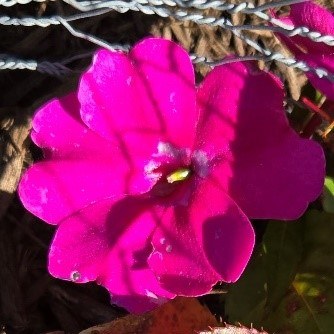
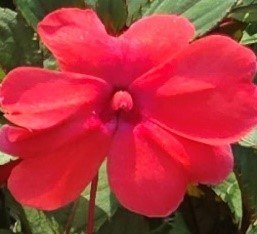

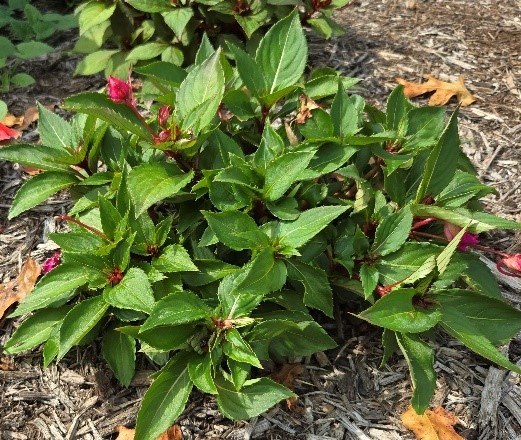
Pentas lanceolata Pentas, Egyptian Star Flower
Height: 12 – 15 inches
Width: 10 – 12 inches
This unnamed cultivar of pentas sports brilliant red flowers with deep green foliage on short compact stems started out as four small plants in a market pack. Not a new cultivar, but such a brilliant red flower could not be passed up. All was well for the three weeks between planting and the first evaluation, earning the plants 19 points out of 20. Then the animal damage began and persisted throughout the growing season. By early August, there was no sign of aboveground growth, but by the end of August, all three plants had foliage, and one plant had three blooms. This would make a lovely bright addition to a protected garden area.
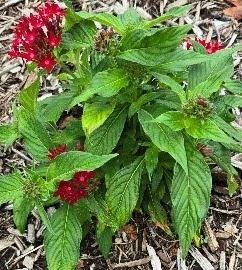
Alstroemeria x hybrida Alstroemeria Inticancha® Paraíso, Peruvian Lily
Height: 12 – 15 inches
Width: 22 – 24 inches
'tt'
Native to South America and perennial in some areas, alstroemeria flowers can reach up to 4 feet in height and are a favorite for cut flowers due to their longevity in a vase. Alstroemeria Inticancha® is a dwarf version of this old favorite with deep purple blooms with a mounding and spreading habit borne from the cluster of tubers that serve as its root system. Noted for profuse flower development from summer through fall, this dwarf variety is well suited to patio pots. The three plants in our garden were quickly devoured. Never having a chance to reach their potential, the vigorous tubers continued to push out new foliage and flowers through the season. In late August, all three plants were visible above ground, and one plant showed three blooms.
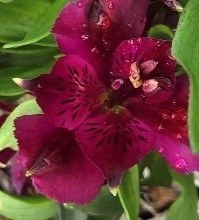
In the 2024 Trial Garden, 11 of the cultivars were evaluated throughout the main summer season, beginning in early June through the end of August. Several suffered some damage from local wildlife, but at least one of the plants in each cultivar group remained viable. Additionally, after a very dry summer, a few cultivars in this group suffered from several contiguous days of heavy downpours. All showed signs of decline at the last evaluation on August 31 or shortly thereafter, so further evaluation was discontinued.
Cuphea procumbens Cuphea Sweet Talk™ Lavender Splash - 82%
Height: 8 – 14 inches
Width: 8 – 14 inches
'tt'
The lovely lavender-colored blooms on this plant are attractive to pollinators and hummingbirds. It is expected to bloom from late spring through summer with a mounded habit. Lavender Splash is one of three colors in the Sweet Talk™ offering from PanAmerican Seed®. The petals fade from a deep purple in the center to white at the outer edges. The plants started out limp with pale foliage and struggled to develop the vigor for upright stems or a mounded appearance. The foliage remained dull until late in the season when it began to develop a healthy green hue, and, while the individual flowers were attractive, the overall presentation of the plants was not. The best-performing plant in the group reached 16 inches in height and 12 inches in width with 80 individual flowers.
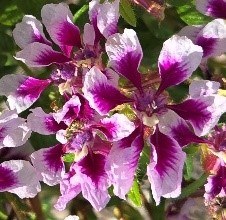
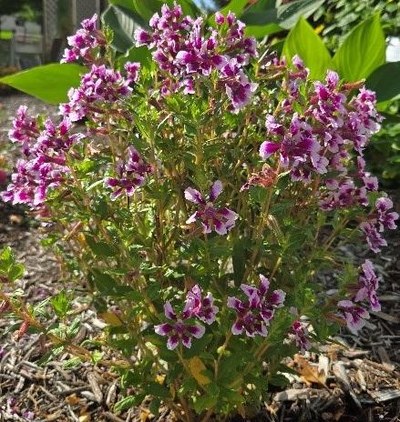
Two plants each of three “True Trial” Geraniums were planted in the Trial Garden this year. Two cultivars in the Mojo™ series from Syngenta Flowers and one cultivar in the Presto™ series from Ball FloraPlant. All three cultivars were hindered by animal damage.
Pelargonium interspecific Geranium Mojo™ Dark Pink - 74%
Height: 12 – 16 inches
Space: 12 – 16 inches
'tt'
Mojo™ Dark Pink, one of ten color offerings in the Mojo™ line, grows in a mounded upright habit. One of the two plants started out significantly smaller than the other and never caught up in growth, resulting in low scores all season in the uniformity category. True to the name, the flowers were dark pink but few in number. The plant never exhibited the dark green foliage that is the hallmark of this line. Recommended care is to water frequently, fertilize every 2 – 3 weeks, and deadhead regularly. Plants in the Trial Garden are not fertilized; this may account for the less-than-stellar performance. The largest plant measured 9 inches high by 7 inches wide with 25 individual flowers on 7 stalks.
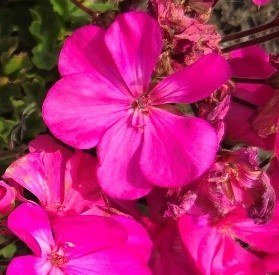
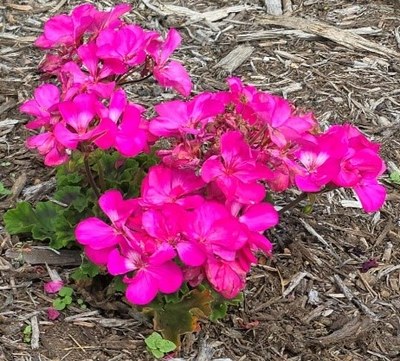
Pelargonium interspecific Geranium Mojo™ Cranberry Splash - 84%
Height: 12 – 16 inches
Space 12 – 16 inches
'tt'
Cranberry Splash, another one of the colors in the Mojo™ line of interspecific geraniums, started with two well-formed plants covered with flowers, and although this line of geraniums is noted for heat resistance, they were unable to maintain steady growth and vigor in the heat of the summer. By mid-summer, flower production was limited to small, sparsely branched plants. Care instructions as stated for Mojo™ Dark Pink, apply to Cranberry Splash. The best performing plant was 9 inches high by 10 inches wide with 25 flowers on 11 stalks.

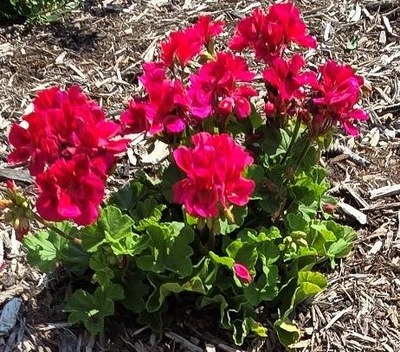
Pelargonium zonal Geranium Presto™ Pink - 91%
Height: 8 – 10 inches
Space 8 inches
'tt'
Presto™ Pink is one of twelve colors offered by Ball FloraPlant in the Presto™ series of zonal geraniums. A compact plant, Presto™ is noted for early bloom time, dark green leaves, and a compact habit, making this geranium well suited to pots and hanging baskets. The two plants were full of flowers at planting, which quickly became a meal for the garden's four-legged residents. Shortly thereafter, one plant was eliminated, so scoring continued for the remaining plant. This plant grew to 8 inches in height by 12 inches wide with 20 flowers on 8 stalks.
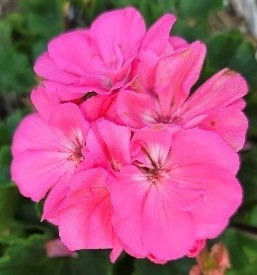
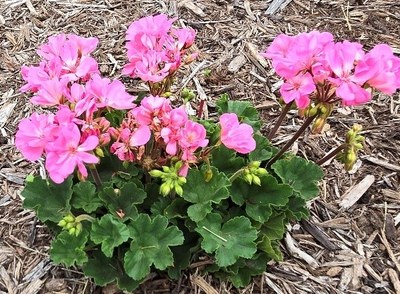
Petunia hybrid Petunia Crazytunia® Frisky Purple - 86%
Height: 10 – 15 inches
Width: 10 – 15 inches
This easy-to-grow petunia is a prolific bloomer with a semi-upright to semi-trailing growth habit. The primarily purple and white trumpet-shaped flowers display a yellow streak that begins at the end of the stem and quickly fades into the white strip of the petal. This multi-branched petunia is a vigorous grower with a somewhat self-cleaning habit; however, removing spent blooms will encourage a more rapid replenishment of blooms. Two of our three plants were pulled out of the ground and replanted early in the season. Thereafter, one was continually uprooted by animals and did not recover. Evaluations were on two plants—one that was unmolested and one that recovered nicely. The best-growing plant in the group reached 12 inches in height and 24 inches in width with 66 flowers.
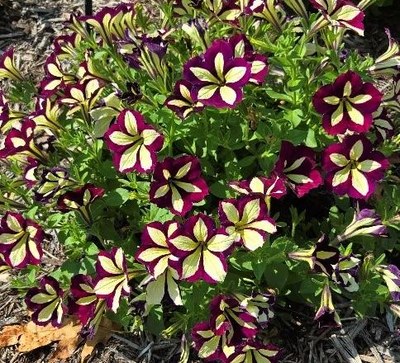
Sutera cordata (Bacopa) Jamesbrittenia hybrid South Africa Phlox Safari® Sky - 86%
Height: 6 – 12 inches
Space: 6 – 10 inches
The Safari® Sky cultivar of Sutera cordata was developed to add a heat-tolerant option to the Sutera cordata (Bacopa) family. A South African species marketed for both hanging baskets or ground plantings, it is expected to bloom all summer. The three plants in the Trial Garden started out as compact plants but quickly got leggy and were never fully covered in blooms. The blooms begin brightly colored with a yellow center with petals that are white near the stem, changing to lavender purple at the ends, then quickly fading to muted colors. By the end of July, the plants were unattractive overall, with few flowers and covered in small seed pods. The best plant in the group reached 9 inches tall and 14 inches wide with 40 flowers.

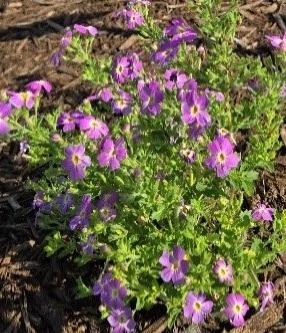
Cuphea hyssopifolia Purple Cuphea 'Mexican Heather' - 87 %
Height: 12 – 24 inches
Space: 12 – 18 inches
'tt'
'Mexican Heather' is a tightly-branched, diminutive plant with tiny purple flowers and tiny, very dark green leaves. Although purple cuphea blooms continuously, the dainty flowers are lost among the glossy, dense foliage. The compact mounding habit makes this plant suitable for borders and containers. By the end of summer, the plants recovered nicely from slight animal browsing in mid-summer but never produced the profusion of deep purple flowers expected. Blooms were sparse and more pink than purple. 'Mexican Heather' reached a height of 6 inches and a width of 11 inches with 60 flowers on one plant at the early August count.
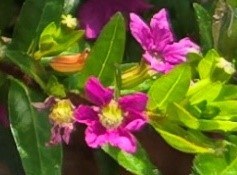
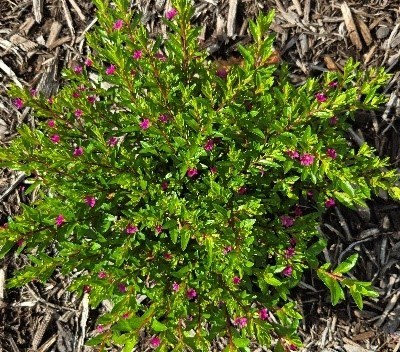
Argyranthemum frutescens Marguerite Daisy Grandaisy® Dark Pink - 93%
Height: 18 – 24 inches
Width: 18 – 24 inches
'tt'
The large, deep pink flowers on this Grandaisy® surrounded by fernlike foliage, made a delightful presentation in the garden. Dark Pink is the latest color offering in this line by Suntory Flowers. True to the line, Grandaisy® Dark Pink maintains a compact, upright habit, and like the Grandaisy® cultivars in last year's Trial Garden, as the flowers age, the color fades, enhancing the presentation with flowers in a variety of pink colors. This year's plants struggled with uniformity. Shortly after planting, they took on one small plant, one medium plant, and one large plant profile. Like last year's Grandaisy®, by mid-August, flower production waned, and the plant began to look untidy. A prolific early-season bloomer, the largest plant measured 18 inches high by 30 inches wide with 50 blooms in early August.

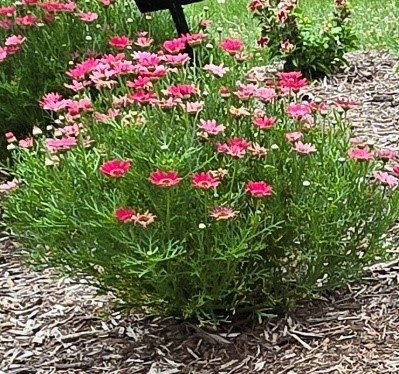
Verbena bonariensis Verbena Meteor Shower® - 95%
Height: 20 – 30 Inches
Space: 8 – 12 inches
An updated cultivar of Verbena bonariensis, Meteor Shower® delivers a denser and more vigorous growth habit. A tall, narrow, and upright plant with two to three clusters of violet to lilac blooms atop stems surrounded by narrow and sparsely placed dark green foliage adds a delicate and airy touch to the garden or mixed containers. Heat and drought-resistant, this is a low-maintenance plant. Deadheading is not necessary, but be aware that it may self-seed. Attractive to both butterflies and hummingbirds, it is not a favorite of deer. This is one of the few flowers in the Trial Garden that was not browsed by wildlife. Some lack of uniformity throughout the season and a decline in flower production after days of rain from Hurricane Debbie in mid-August cost this group a perfect score. With 176 blooms, the best of the three plants reached 22 inches in height and 29 inches in width. By the end of August, while still a somewhat attractive presentation, the group of three plants held as many new blooms as spent flowers.
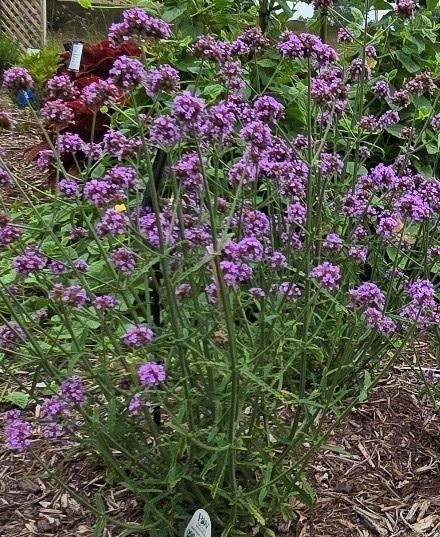
Lobelia hybrid Lobelia 'Rift Blue' - 97%
Height: 8 – 12 inches
Space: 6 – 8 inches
One look was all it took for 'Rift Blue' to obtain a place in this year's Trial Garden. With masses of dainty blue and white streaked flowers with tiny yellow tear drops near the stem on a slender stem in the classic Lobelia form, this Lobelia hybrid was a wonderful addition to the garden. The uniformity category kept this group of three petite plants from a perfect score. The blooms were plentiful, but after the heavy downpours in early August, many of the booms faded, leaving the plants with an overall brown cast at the end of the season. 90 flowers were counted on one plant measuring 10 inches high and 18 inches wide.

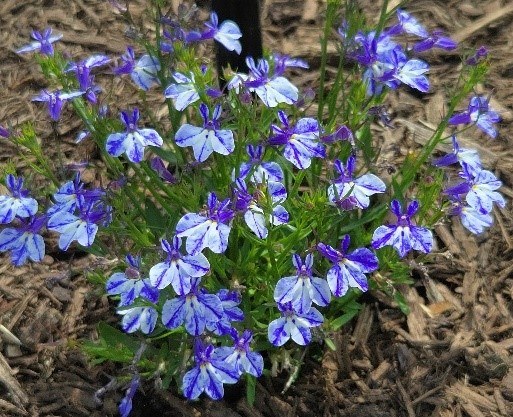
Scaevola hybrid Scaevola Surdiva® Blue Violet - 99%*
Height: 6 – 8 inches
Space: 12 – 24 inches
Surdiva® Blue Violet displays fan-shaped flowers leaning to more purple than blue on low-growing semi-trailing plants with a compact mounded habit. These plants are heat tolerant and self-cleaning, making them a low-maintenance addition to garden beds, containers, and hanging baskets. This Scaevola was a complete knock-out in the garden, achieving an almost perfect score from the first evaluation in June through the first evaluation in August. Shortly thereafter, the 4.5 inches of rain over several days in early August had a dramatic negative impact on this cultivar, which does best in a well-drained environment. Surdiva® Blue Violet quickly turned brown, at which point evaluations ended. The plants were superb while they lasted. The largest plant was 6 inches high, 24 inches in width, with 420 individual flowers.
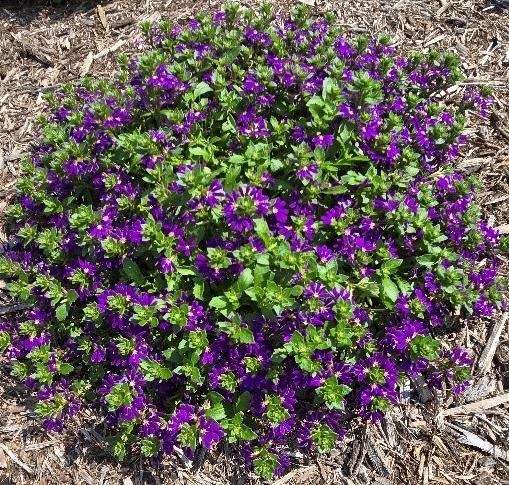
*The score of 99% was achieved in 5 evaluations rather than in 7 evaluations as the other plants in this group.
Fall-worthy Plants
In the 2024 Trial Garden, 14 of the 29 cultivars continued to thrive through the month of September when a final evaluation was conducted for these “fall worthy” survivors. Noteworthy is that this group was not attractive to the area's wildlife and remained attractive through extreme heat, weeks of drought, a deluge of rain followed by more drought and ending with more heavy rain. Many are “True Trials” cultivars; all are true survivors.
The first score listed is for the full evaluation period of June through September; the second score display in parenthesis was calculated from the ratings up to the end of August.
Agastache aurantiaca Hyssop 'Betterbuzz Amber' - 74% (75%)
Height: 14 – 16 inches
Width: 12 inches
With muted orange blooms and the traditional aromatic foliage of hyssop, 'Betterbuzz Amber' attracts pollinators and repels browsing animals. The flowers on this hybrid have a delicate appearance beginning as a deep orange and transforming through a light orange, and ending as an almost golden orange before setting seed pods. All three plants seemed to struggle in the heat and never showed a vigorous growth rate. The dark green foliage made a lovely contrast to the orange blooms but began to show yellowing by early August when the previously plentiful blooms turned to seed pods, detracting from the overall appearance of the group. Uniformity and less than vigorous growth hurt this plant's rating. Although they remained viable through September, the performance did not improve. This cultivar achieved a 4.1 rating out of 5 in the 2023 Penn State Flower Trials, where it was noted that the plants were not in flower at the August and September evaluations. Achieving a height of 18 inches and 13 inches in width, the largest plant in our garden held 68 flowering stems.
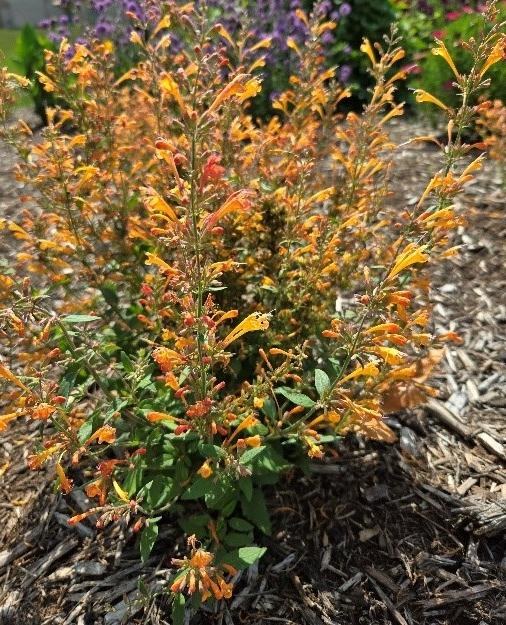
Angelonia angustifolia Angelonia Archangel™ Ruby Sangria - 87% (86%)
Height: 14 – 16 inches
Width: 10 – 12 inches
'tt'
Archangel™ Ruby Sangria has deep red blooms covering upright stems amid shiny dark green foliage. The scented foliage may have served as a deterrent to hungry wildlife, as this plant was untouched by browsing. The plants are not as densely packed as some Angelonia, giving a more open appearance. Uneven uniformity and growth were observed until mid-summer, when flowers became abundant, and the growth rate increased. Also, about this time, the foliage began to yellow. Late summer and into September, although the foliage was in decline, the profusion of deep red flowers persisted, and the plants continued to grow. With 594 flowers on 11 stems, the largest plant measured 14 inches high by 34 inches wide.
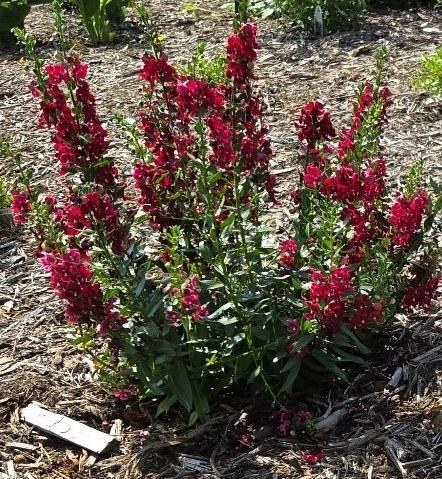
Salvia officinalis Salvia Salgoon® Lake Como - 87% (85%)
Height: 20 inches
Width: 20 inches
'tt'
'Lake Como' presents as a compact, upright plant with study branches and dark green, heart-shaped, deeply toothed leaves. The lavender blue blooms borne on sturdy branches are attractive to butterflies and bees and the textured foliage is unattractive to animals. The Salgoon® series is heat-tolerant and drought-resistant and continues to produce flowers through Autumn. Lake Como was slow to grow until late July, and even then, although the growth rate improved, it still did not reach the expected size. Late in August, the plants began to increase in size rapidly. Flower production was even for most of the summer, beginning in early July. The largest plant reached 21 inches high by 23 inches wide, displaying 180 flowers on 30 stalks and an additional 25 stalks with unopened buds.
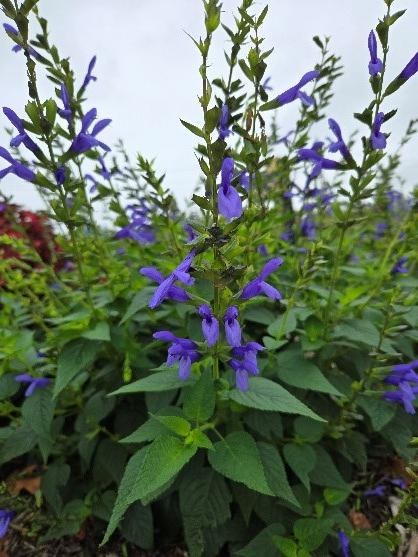
Catharanthus hybrid Vinca SOIREE® Flamenco Salsa Red - 90% (91%)
Height: 8 – 12 inches
Width: 12- 16 inches
'tt'
Flamenco Salsa Red is the latest color offering in the SOIREE® Flamenco series from Suntory Flowers. The deep red and white bicolored flowers have fringed, ruffled petals paired with glossy dark green leaves, giving a dramatic new look to this annual vinca. With a mounded habit, this Vinca is covered with blooms all summer into fall. Slow to grow in the early season, Salsa Red exceeded the expected 16-inch spread to reach 24 inches in width on a 12-inch high plant with 72 gorgeous flowers. Uniformity was a problem from mid-season until late in the summer when it was difficult to tell where one plant ended and another began.

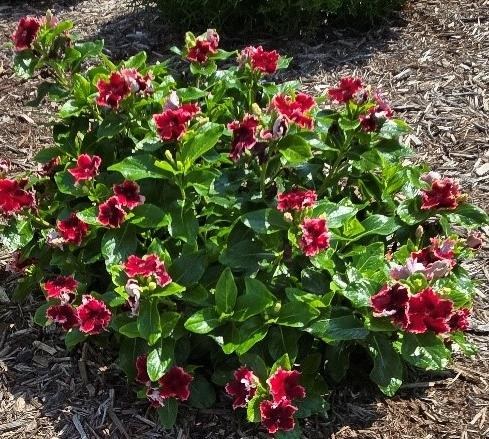
Canna x generalis Canna Lily Cannova® Golden Leopard - 91% (90%)
Height: 30 – 48 inches
Width: 24 inches
'tt'
Cannas have always added a bit of an exotic tropical feel to the garden with their wide green leaves and brightly colored flowers. Cannova® Golden Leopard takes that tropical feel one step further with bright golden blooms splashed with orange spots – a striking contrast with the solid green leaves. The shorter size of this canna lily makes it suitable for container use as well as in the landscape. Three small potted plants without flowers were placed in the garden in May and were quickly devoured by hungry wildlife. Nothing could be seen above ground. With cages and some protection from fast-growing neighboring annuals, by mid-summer, new foliage appeared. By August, they were recovering enough foliage to be attractive and began generating flowers achieving near-perfect scores from that point forward. Size measurements in early August were certainly affected by the continual early season browsing; still, the largest plant measured 22 inches high by 24 inches wide with four stunning flower stalks. At the end of September evaluation, Golden Leopard met the expected height for this cultivar.
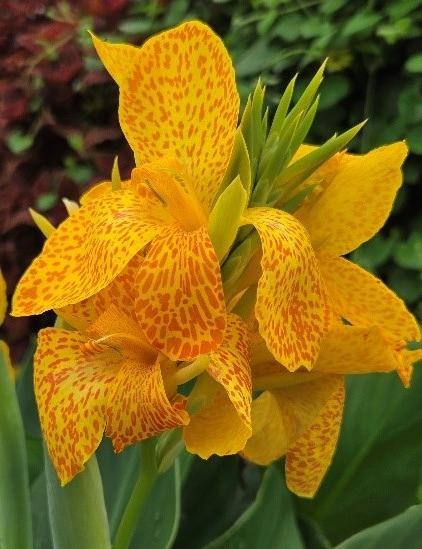
Celosia spicata Celosia Kelos® Fire Orange - 94% (93%)
Height: 16 inches
Space: 10 inches
'tt'
Fire Orange is an apt name for this celosia. Large bright plumes atop sturdy yellow-tinted stems suggest a warm winter fire. The dazzling color of the medium green leaves and deep orange plumes retained their vibrant color all season. This dense, upright Celosia bloomed profusely throughout the summer. The plants showed minor insect damage early in the season and lacked uniformity throughout the summer. Lack of perfection is not always unwelcome, as the different-sized plants portrayed a waterfall effect of orange plumes in the garden grouping. Far exceeding the size expectation, the largest plant in the group measured 25 inches tall and 24 inches wide with 20 deep orange plumes.
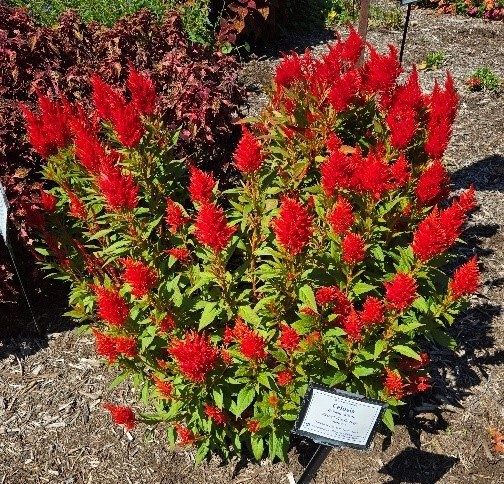
Bidens ferulifolia Bidens Brazen™ Red Flare - 94% (94%)
Height: 8 – 12 inches
Space: 16 – 24 inches
Bidens are a reliable garden annual for continuous blooms with a low upright mounded profile. Generally carefree, Bidens establish easily, are heat tolerant, and bloom readily without deadheading. Brazen™ Red Flare brings a mix of striking flowers in hues of yellow, orange, and red. The flowers have eight clearly distinguishable petals surrounding a sunny center. Although the three plants got off to a slow start—lacking uniformity, growth, and flower coverage—by July, they were stars in the garden, garnering nearly perfect scores from early July through the end of September. There was some center dieback at the end of September, but still, there were many new blooms forming. With 120 open flowers and as many unopened blooms, the largest plant measured 11 inches high by 25 inches wide.
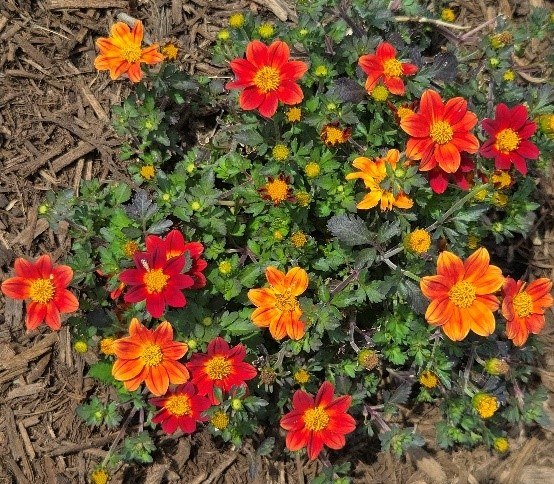
Plectranthus scutellarioides Coleus Talavera™ Moondust - 95% (94%)
Height: 14 - 36 inches
Space: 12 – 18 inches
'tt'
Talavera™ Moondust is a bushy upright coleus suitable for both sunny and shade conditions. This late-flowering, non-bolting coleus maintains a tight shape, vibrant color, and foliage pattern in full sun conditions. Deep maroon, serrated leaves are edged with light lime-yellow and speckled with the same lime-yellow colored moondust. Grown for the foliage, Talavera™ Moondust was not judged in the flower category. Achieving perfect scores in both foliage and growth and uniformity was the obstacle to a higher score. One plant started out smaller than the other two, and as the season progressed, the three plants took on one small, one medium, and one large profile until late summer when the two smaller plants caught up with the size leader that reached 32 inches high and 36 inches in width.
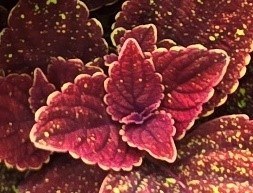
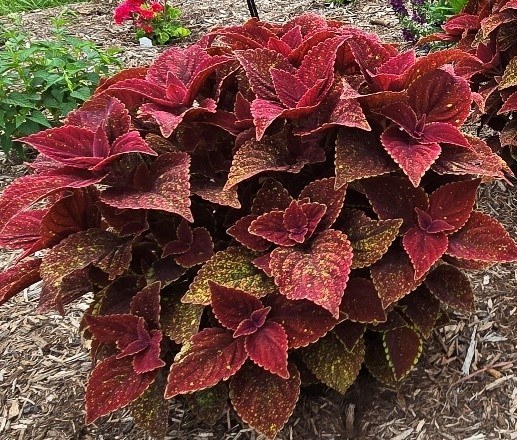
Lantana camara Lantana Bandito™ Orange Sunrise - 95% (94%)
Height: 10 – 12 inches
Space: 10 – 12 inches
'tt'
The Bandito™ series of Lantana provides compact plants with summer-long color in numerous shades, ideal for containers as well as bedding plants. The flower clusters on Orange Sunrise range from pale yellow through deep orange on mounded upright plants. New booms take on an almost pinkish color before opening. These heat-tolerant, lightly scented plants are attractive to butterflies and hummingbirds, while their textured, somewhat stiff foliage is not pleasant for herbivores. Uniformity, again, was an early obstacle for this cultivar. However, from mid-summer through fall, perfect scores of 5 were reached across all categories. One plant reached 11 inches tall and 23 inches wide with 128 flower clusters.

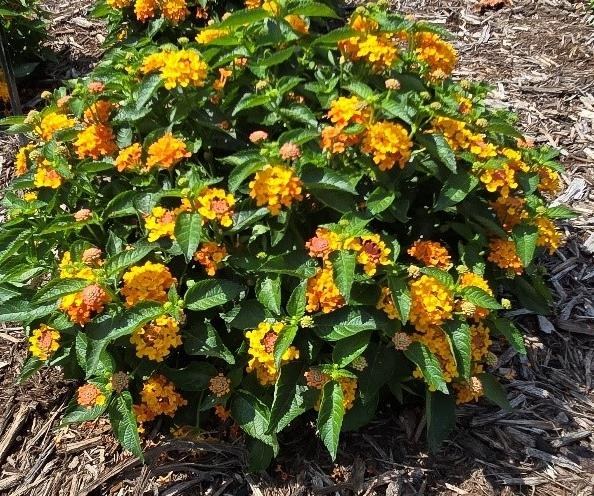
Coleus scutellarioides Coleus Down Town™ Santa Monica - 96% (97%)
Height: 10 – 16 inches
Width: 9 – 12 inches
'tt'
The multicolored burgundy leaves with deeply serrated edges of Down Town™ Santa Monica immediately attract attention in the garden. The somewhat narrow leaves are closely positioned on sturdy stems. Another coleus marketed for sun or shade, Down Town™ Santa Monica retained brilliant color in our full sun garden. No flower production throughout the season preserved the fullness of the display. After overcoming a size difference among the three plants, scores of 5 across the board were achieved until late September, when one plant began to fade. A vigorous grower, the largest plant reached 24 inches in height by 32 inches wide, far exceeding expected growth.


Lantana camara Lantana 'Passionfruit' - 96% (95%)
Height: 12 - 16 inches
Width: 12 – 14 inches
'tt'
This spreading lantana is a compact variety suitable for containers, hanging baskets, or as a bedding plant. 'Passionfruit' continuously produces clusters of multicolored flowers in shades of pink, yellow, and orange with dark green, scented foliage. It is drought-resistant and heat-tolerant and a favorite of pollinators. The stiff texture of the foliage and woody scent ward off predators. The thinly branched plants started slow and lacked uniformity early in the season. By mid-July, they flourished, scoring solid 5s in all categories for the remainder of the season. Stretching beyond the expected size, the largest plant was 18 inches high, a full 3 feet in width, with 200 flower clusters.

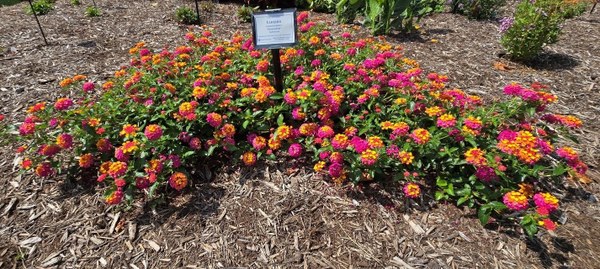
Melampodium paludosum African Zinnia Jackpot Gold™ - 97% (96%)
Height: 8 – 12 inches
Space: 12 inches
Jackpot Gold™, covered in sunny yellow flowers, created an exquisitely beautiful display in this year's Trial Garden. Large flowers that can reach 2 inches across cover these heat-tolerant tidy plants, which are unfazed by humidity, dry or poor soils. The upright-mounded growth habit and prolific blooms are maintained throughout the season. The plants started out as small plants in a 4-cell pack, already blooming, and grew to plants up to 14 inches high and 34 inches across with 440 blooms on one plant. Again, it was the uniformity, especially early in the season, that denied Jackpot Gold™ a perfect score. Touted as deer and rabbit-resistant, there was no animal damage to these plants.
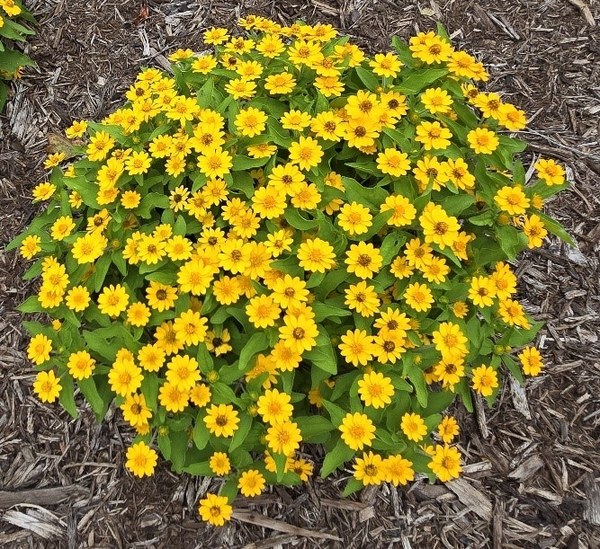
Angelonia angustifolia Angelonia Alonia™ Big Grape - 98% (100%)
Height: 14 – 16 inches
Spacing: 12 – 14 inches
'tt'
Simply stunning, Alonia™ Big Grape's tall flower spikes are densely covered with deep purple-black flowers with white highlights on the lips. With the bushy, somewhat sprawling form classic of angelonia, no support is needed to keep the heavily laden stems upright. This early blooming, drought-tolerant cultivar continues to produce flowers and gain size throughout the season. The three plants in our garden were perfectly matched in size when planted and retained the same rate of growth for much of the summer. One plant fell slightly behind in July, costing this group half a point during the main season evaluations with perfect scores of 5. With rounding, a 100% score was awarded for the period from June through the end of August. Still looking good, but no longer perfect, Big Grape was included in the evaluation at the end of September, at which point it slipped to 98%. Nonetheless, this plant is a magnificent addition to the garden. With 54 flower spikes holding 11 open buds each, 23 inches high and 18 inches wide, Big Grape is another cultivar that exceeded size expectations.

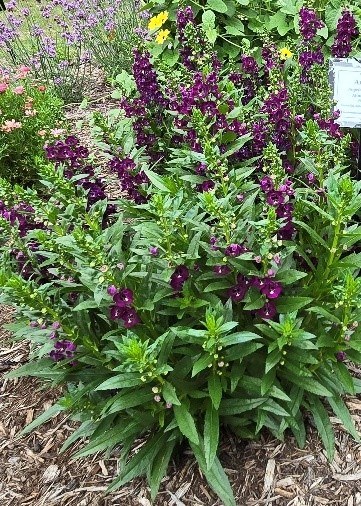
Thunbergia alata Black-eyed Susan Vine Sunny™ Lemon Star - 100% (100%)
Height: 5 – 8 feet
Width: 3 feet
Chosen as a centerpiece for the garden, one plant of black-eyed susan vine Sunny™ Lemon Star was planted. The brightly colored yellow flowers with five petals around a purple-brown center are surrounded by heart-shaped leaves that are soft and slightly velvety. Although an upright support structure was provided, it quickly became clear that this vine would rather trail than climb; it needed a lot of help to wrap around and move upward on the vertical posts of the offered trellis. It also liked using neighboring plants for support. Perfect scores of 5 all season in the three categories of flower, foliage, and growth – landed Sunny™ Lemon Star a 100% rating in the main season and through the extended evaluation season. The flower count was next to impossible on this 4-foot-high by 4-foot-wide vine. The outside layer had 44 open blooms with many more new buds waiting to open.
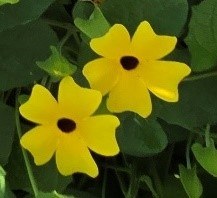
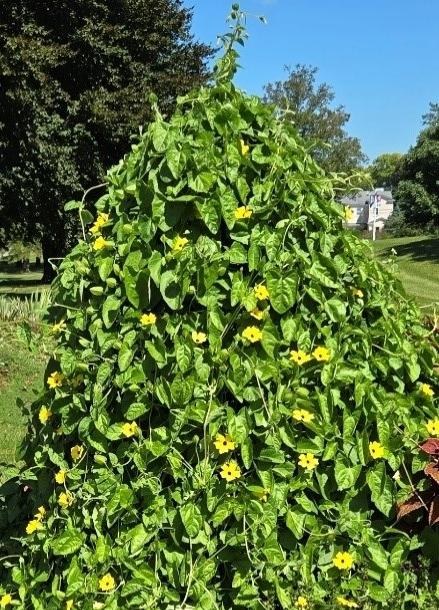
The chart below summarizes the performance of the 25 cultivars that were included in the evaluation process from June through at least August. For those that were evaluated in September, a second score is listed. For those plants that thrived into September, the score for the June through August period was similar to their score for the June through September period, usually within one percentage point of each other. In some cases, the earlier score is higher, whereas, in other cases, the later score is higher.
2024 Trial and Idea Garden Consolidated View of Ratings
| True Trial | Botanical Name | Common Name and Cultivar | End August Rating |
End September Rating |
|---|---|---|---|---|
|
|
Agastache aurantiaca |
Hyssop 'Betterbuzz Amber' |
75 |
74 |
|
tt |
Angelonia angustifolia |
Angelonia Alonia™ Big Grape |
99 |
98 |
|
tt |
Angelonia angustifolia |
Angelonia Archangel™ Ruby Sangria |
87 |
86 |
|
tt |
Argyranthemum frutescens |
Marguerite Daisy Grandaisy® Dark Pink |
93 |
|
|
|
Bidens ferulifolia |
Bidens Brazen ™ Red Flare |
94 |
94 |
|
tt |
Canna x generalis |
Canna Lily Cannova® Golden Leopard |
90 |
91 |
|
tt |
Catharanthus hybrid |
Vinca SOIREE® Flamenco Salsa Red |
91 |
90 |
|
tt |
Celosia spicata |
Celosia Kelos® Fire Orange |
93 |
94 |
|
tt |
Coleus scutellarioides |
Coleus Down Town™ Santa Monica |
97 |
96 |
|
tt |
Cuphea hyssopifolia |
Purple Cuphea 'Mexican Heather' |
87 |
|
|
tt |
Cuphea procumbens |
Cuphea Sweet Talk™ Lavendar Splash |
82 |
|
|
tt |
Lantana camara |
Lantana 'Passionfruit' |
95 |
96 |
|
|
Lantana camara |
Lantana Bandito™ Orange Sunrise |
94 |
95 |
|
|
Lobelia hybrid |
Lobelia 'Rift Blue' |
97 |
|
|
|
Melampodium paludosum |
African Zinnia Jackpot Gold™ |
96 |
97 |
|
tt |
Pelargonium interspecific |
Geranium Mojo™ Dark Pink |
74 |
|
|
tt |
Pelargonium interspecific |
Geranium Mojo™ Cranberry Splash |
84 |
|
|
tt |
Pelargonium zonal |
Geranium Presto™ Pink |
91 |
|
|
|
Petunia hybrid |
Petunia Crazytunia® Frisky Purple |
86 |
|
|
tt |
Plectranthus scutellarioides |
Coleus Talavera™ Moondust Coleus |
94 |
95 |
|
tt |
Salvia officinalis |
Salvia Salgoon® Lake Como |
85 |
87 |
|
|
Scaevola hybrid |
Scaevola Surdiva® Blue Violet |
99* |
|
|
|
Sutera cordata (Bacopa) |
South African Phlox Safari® Sky Jamesbrittenia Hybrid |
89 |
|
|
|
Thunbergia alata |
Black-eyed Susan Vine Thunbergia Sunny™ Lemon Star |
100 |
100 |
|
|
Verbena bonariensis |
Verbena Meteor Shower® |
95 |
|
* Scaevola Surdiva® Blue Violet was included only in five of the seven evaluations during the summer period of June through August.
Content courtesy of the Penn State Master Gardeners of Cumberland County Trial and Idea Garden Committee members.
Photo Credit: Penn State Extension Master Gardener Janey Gunn unless otherwise noted.

